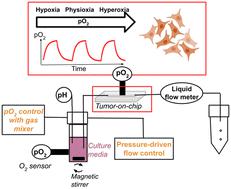Our official English website, www.x-mol.net, welcomes your
feedback! (Note: you will need to create a separate account there.)
Precise and fast control of the dissolved oxygen level for tumor-on-chip
Lab on a Chip ( IF 6.1 ) Pub Date : 2022-10-31 , DOI: 10.1039/d2lc00696k Charlotte Bouquerel 1, 2, 3 , William César 2 , Lara Barthod 1 , Sarah Arrak 1 , Aude Battistella 4 , Giacomo Gropplero 1 , Fatima Mechta-Grigoriou 3 , Gérard Zalcman 3 , Maria Carla Parrini 3 , Marine Verhulsel 2 , Stéphanie Descroix 1
Lab on a Chip ( IF 6.1 ) Pub Date : 2022-10-31 , DOI: 10.1039/d2lc00696k Charlotte Bouquerel 1, 2, 3 , William César 2 , Lara Barthod 1 , Sarah Arrak 1 , Aude Battistella 4 , Giacomo Gropplero 1 , Fatima Mechta-Grigoriou 3 , Gérard Zalcman 3 , Maria Carla Parrini 3 , Marine Verhulsel 2 , Stéphanie Descroix 1
Affiliation

|
In vitro cell cultures are most often performed in unphysiological hyperoxia since the oxygen partial pressure of conventional incubators is set at 141 mmHg (18.6%, close to ambient air oxygen 20.1%). This value is higher than human tissue oxygen levels, as the in vivo oxygen partial pressures range from 104 mmHg (lung alveoli) to 8 mmHg (skin epidermis). Importantly, under pathological conditions such as cancer, cells can experience oxygen pressure lower than the healthy tissue. Although hypoxic incubators can regulate gas oxygen, they do not take into account the dissolved oxygen concentration in the cell culture medium. In the context of organ on chip and micro-physiological system development, we present here a new system, called Oxalis (OXygen ALImentation System) that allows fine control of the dissolved oxygen level in the cell culture medium. Oxalis regulates simultaneously the gas composition and the inlet reservoir pressure by modulating the pneumatic valve opening. This dual regulation allows both the pressure driven liquid flowrate and the level of oxygen dissolved in the chip to be controlled independently. Oxalis offers unprecedented features such as an oxygen equilibration time lower than 3 minutes and an accuracy of 3 mmHg. These performances can be reached for chip perfusion flow as low as 1 μL min−1. This low flow rate allows the shear stress experienced by the cells in the chip to be accurately controlled. In addition, the system enables modulation of the pH in the cell culture medium through the modulation of CO2. The fine control and monitoring of both O2 and pH pave the way for new precise investigations on physiological and pathological biological processes. Using Oxalis in the context of tumor-on-chip, we demonstrate the capacity of the system to recapitulate hypoxia-induced gene expression, offering an innovative strategy for future studies on the role of hypoxia in malignant progression and drug resistance.
中文翻译:

精确快速控制芯片上肿瘤的溶解氧水平
体外细胞培养最常在非生理性高氧条件下进行,因为常规培养箱的氧分压设定为 141 mmHg(18.6%,接近环境空气氧的 20.1%)。该值高于人体组织含氧量,因为体内氧分压范围从 104 mmHg(肺泡)到 8 mmHg(皮肤表皮)。重要的是,在癌症等病理条件下,细胞的氧压可能低于健康组织。低氧培养箱虽然可以调节气体含氧量,但没有考虑到细胞培养基中溶解氧的浓度。在芯片器官和微生理系统开发的背景下,我们在这里展示了一种名为 Oxalis(OXygen ALImentation System)的新系统,它可以精细控制细胞培养基中的溶解氧水平。Oxalis 通过调节气动阀开度同时调节气体成分和入口储罐压力。这种双重调节允许独立控制压力驱动的液体流速和溶解在芯片中的氧气水平。Oxalis 提供了前所未有的功能,例如氧气平衡时间低于 3 分钟,精度为 3 mmHg。低至 1 μL min 的芯片灌注流量即可达到这些性能-1。这种低流速允许精确控制芯片中细胞所经历的剪切应力。此外,该系统能够通过调节 CO 2来调节细胞培养基中的 pH 值。O 2和pH的精细控制和监测为对生理和病理生物过程进行新的精确研究铺平了道路。在芯片肿瘤的背景下使用 Oxalis,我们展示了该系统重现缺氧诱导基因表达的能力,为未来研究缺氧在恶性进展和耐药性中的作用提供了创新策略。
更新日期:2022-10-31
中文翻译:

精确快速控制芯片上肿瘤的溶解氧水平
体外细胞培养最常在非生理性高氧条件下进行,因为常规培养箱的氧分压设定为 141 mmHg(18.6%,接近环境空气氧的 20.1%)。该值高于人体组织含氧量,因为体内氧分压范围从 104 mmHg(肺泡)到 8 mmHg(皮肤表皮)。重要的是,在癌症等病理条件下,细胞的氧压可能低于健康组织。低氧培养箱虽然可以调节气体含氧量,但没有考虑到细胞培养基中溶解氧的浓度。在芯片器官和微生理系统开发的背景下,我们在这里展示了一种名为 Oxalis(OXygen ALImentation System)的新系统,它可以精细控制细胞培养基中的溶解氧水平。Oxalis 通过调节气动阀开度同时调节气体成分和入口储罐压力。这种双重调节允许独立控制压力驱动的液体流速和溶解在芯片中的氧气水平。Oxalis 提供了前所未有的功能,例如氧气平衡时间低于 3 分钟,精度为 3 mmHg。低至 1 μL min 的芯片灌注流量即可达到这些性能-1。这种低流速允许精确控制芯片中细胞所经历的剪切应力。此外,该系统能够通过调节 CO 2来调节细胞培养基中的 pH 值。O 2和pH的精细控制和监测为对生理和病理生物过程进行新的精确研究铺平了道路。在芯片肿瘤的背景下使用 Oxalis,我们展示了该系统重现缺氧诱导基因表达的能力,为未来研究缺氧在恶性进展和耐药性中的作用提供了创新策略。











































 京公网安备 11010802027423号
京公网安备 11010802027423号